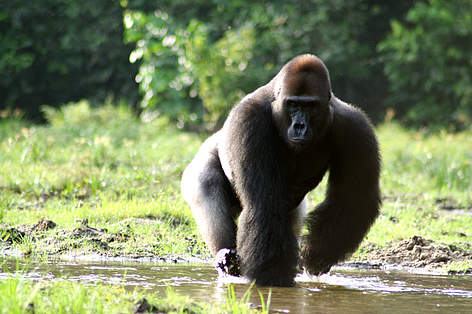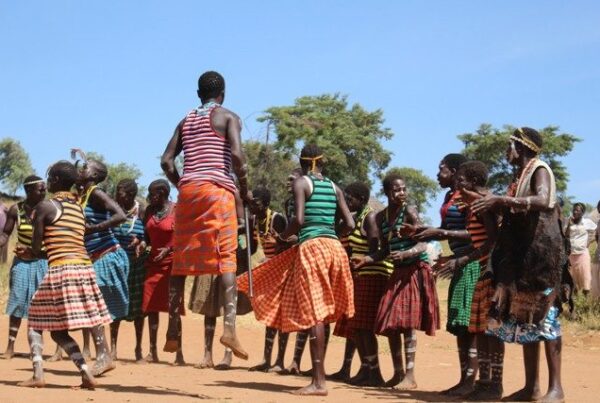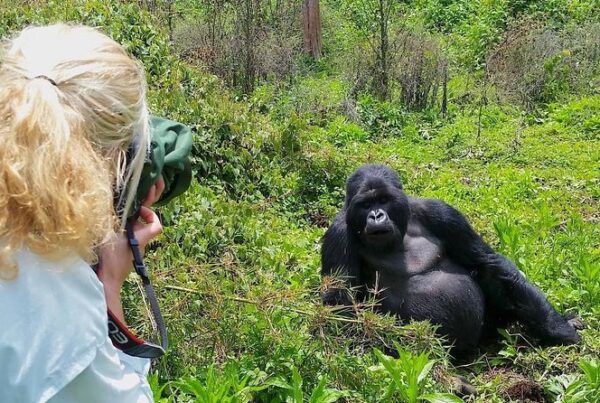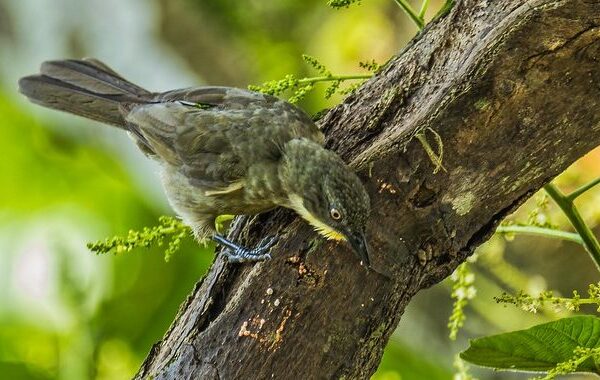Western Gorilla: The Gentle Giants of Africa’s Rainforests
Encountering the Silent Giants
In the dense tropical forests of Central and West Africa, where sunlight penetrates only in scattered beams and the air is heavy with the scent of earth and foliage, a remarkable primate moves with quiet authority. The Western Gorilla (Gorilla gorilla), the largest of all primates on the African continent, commands both fascination and respect, embodying the delicate balance between strength and vulnerability in the wild. Its presence in the rainforest is both majestic and crucial, symbolizing the richness of biodiversity and the fragility of ecosystems under pressure from human activity.
Despite their imposing size and apparent resilience, Western Gorillas face a precarious existence. Populations are threatened by poaching, habitat destruction, and disease, making conservation efforts more urgent than ever. Understanding the biology, ecology, and social behavior of the Western Gorilla offers insight into a species whose survival is intimately tied to the health of Africa’s forests. The Western Gorilla is not merely a wildlife icon; it represents the intricate interdependence between species, habitats, and human responsibility.
Taxonomy and Subspecies
The Western Gorilla belongs to the genus Gorilla, which is divided into two primary species: the Western Gorilla (Gorilla gorilla) and the Eastern Gorilla (Gorilla beringei). Within the Western species, two subspecies are recognized: the Western Lowland Gorilla (Gorilla gorilla gorilla) and the Cross River Gorilla (Gorilla gorilla diehli).
The Western Lowland Gorilla is the most widely distributed and numerous subspecies, inhabiting lowland tropical forests and swampy areas of countries including Cameroon, Gabon, the Republic of Congo, and the Central African Republic. The Cross River Gorilla is highly restricted, found in a small region along the Nigeria-Cameroon border, and is considered one of the rarest great apes on Earth. Differences in morphology, genetics, and behavior reflect adaptations to the specific ecological niches occupied by each subspecies, although both share fundamental traits such as social complexity, intelligence, and emotional depth.
Physical Characteristics
Western Gorillas are renowned for their impressive size, muscular build, and unique features. Adult males, referred to as silverbacks because of the silvery hair that develops along their backs with age, can weigh between 140 to 200 kilograms and stand over 1.7 meters tall when upright. Females are smaller, typically weighing around 70 to 90 kilograms, yet they display considerable strength and endurance, enabling them to forage and care for their young within dense forest environments.
The facial features of the Western Gorilla are expressive and convey a range of emotions, from curiosity and playfulness to alertness and aggression. Eyes are deep-set and intelligent, noses are broad, and brow ridges are prominent, giving the gorilla a distinctive and commanding appearance. The fur is generally dark brown to black, sometimes exhibiting a reddish tint on the forehead and shoulders. The limbs are long and muscular, facilitating knuckle-walking, climbing, and occasional bipedal posture when necessary. The hands and feet are dexterous, allowing for manipulation of vegetation, foraging tools, and nesting materials.
Habitat and Geographic Distribution
The habitat of the Western Gorilla is predominantly lowland tropical rainforest, though swamp forests, secondary forests, and forest-savanna mosaics are also utilized. These forests are characterized by high rainfall, humidity, and diverse vegetation, creating an environment rich in food resources and shelter. The Western Lowland Gorilla occupies regions spanning Cameroon, Gabon, Equatorial Guinea, the Republic of Congo, and parts of Angola and the Central African Republic. Cross River Gorillas are confined to the mountainous and hilly forests of southeastern Nigeria and western Cameroon.
The distribution of Western Gorillas is heavily influenced by the availability of food, forest density, and water sources. Seasonal variations affect ranging behavior, diet, and group movements. Forest fragmentation caused by logging, agriculture, and mining has increasingly isolated populations, reducing genetic diversity and complicating conservation strategies. Despite these challenges, Western Gorillas have demonstrated remarkable adaptability, navigating both primary and secondary forests to meet their nutritional and social needs.
Social Structure and Behavior
Western Gorillas live in highly organized social groups known as troops, typically led by a dominant silverback. This male assumes responsibility for protecting the group, mediating conflicts, and maintaining cohesion. Troops generally consist of multiple adult females, their offspring, and subordinate males known as blackbacks, who have yet to establish their own territories or leadership.
Social behavior is complex and multifaceted. Grooming is a critical activity, serving both hygienic and social purposes, strengthening bonds, and reducing tension. Play among juveniles fosters physical development, social skills, and problem-solving abilities, while vocalizations, chest-beating, and other displays communicate dominance, alert the group to potential threats, and express emotional states. Nest-building, a daily ritual, involves constructing platforms of leaves and branches for sleeping, either on the ground or in trees, reflecting intelligence, planning, and learned behaviors transmitted through observation and imitation.
Diet and Feeding Patterns
Western Gorillas are primarily herbivorous, relying on a wide range of plant material, including leaves, stems, fruits, seeds, and occasionally flowers. The Western Lowland Gorilla’s diet is especially varied, allowing adaptation to seasonal changes and environmental availability. Foraging behavior is strategic, often involving travel over several kilometers to reach fruiting trees or swampy areas rich in herbaceous vegetation.
Feeding not only sustains the gorillas physically but also plays a crucial ecological role. Through seed dispersal, Western Gorillas facilitate forest regeneration and maintain plant diversity. The construction of feeding platforms and manipulation of vegetation creates microhabitats for insects and smaller wildlife, reinforcing the gorilla’s role as a keystone species within their ecosystem.
Reproduction and Life Cycle
Reproductive behavior is closely tied to the social hierarchy within Western Gorilla troops. Females reach sexual maturity between 8 and 10 years, while males mature later, achieving full silverback status around 12 to 15 years. Dominant silverbacks usually monopolize mating opportunities, ensuring the propagation of their genetic lineage and maintaining group stability.
Gestation lasts approximately 8.5 months, producing a single infant per birth. Twin births are exceedingly rare and carry substantial survival challenges. Infants are heavily dependent on maternal care during the first few years of life, gradually learning foraging skills, social behavior, and environmental navigation. Lifespan in the wild typically ranges from 35 to 40 years, though threats such as poaching, disease, and habitat loss frequently reduce longevity. The developmental stages of Western Gorillas are characterized by social learning, observation, and the gradual assumption of adult roles within the troop.
Communication and Intelligence
The intelligence of Western Gorillas is reflected in their communication, problem-solving abilities, and social strategies. Vocalizations include grunts, barks, and roars, each serving a distinct purpose, from signaling danger to asserting dominance or expressing satisfaction. Non-verbal communication, such as facial expressions, postures, and gestures, complements vocal signals, conveying nuanced messages within the troop.
Observations of tool use, although less frequent than in some other primates, have been documented. Gorillas manipulate sticks to test water depth, strip leaves for bedding, or reach otherwise inaccessible food. Cognitive abilities such as memory, learning, and empathy have been recorded, highlighting the gorilla’s complex emotional and intellectual capacities. Such intelligence underscores the importance of ethical conservation practices and the protection of their natural habitats.
Conservation Status and Threats
The Western Gorilla is classified as Critically Endangered by the International Union for Conservation of Nature (IUCN). Populations have declined dramatically over the past century due to poaching, habitat destruction, disease, and political instability in range countries. The bushmeat trade and illegal wildlife trafficking remain persistent threats, while logging, mining, and agricultural expansion fragment habitats and reduce connectivity between populations.
Ebola outbreaks have had devastating effects on Western Gorilla populations, decimating entire troops and further complicating conservation efforts. Disease transmission, often exacerbated by human encroachment, continues to pose significant challenges. Protected areas such as Loango National Park in Gabon, Odzala-Kokoua National Park in the Republic of Congo, and Cross River protected forests in Nigeria provide critical refuges, yet enforcement and monitoring remain difficult in remote regions.
Conservation initiatives emphasize habitat protection, anti-poaching patrols, research, and community engagement. Ecotourism has emerged as a vital tool, providing funding, employment, and global awareness. Responsible visitation programs, where human interaction is carefully managed, allow gorilla observation without compromising their safety or health, creating a sustainable model for both conservation and local economic development.
Ecological Importance
Western Gorillas function as keystone species, shaping the structure and health of tropical forests. Through seed dispersal, they promote plant diversity and forest regeneration, while their feeding and nesting behaviors create microhabitats that support a range of other organisms. The decline of Western Gorilla populations would have profound cascading effects on ecosystem stability, underscoring their critical ecological role.
By maintaining forest integrity, Western Gorillas indirectly support biodiversity, water regulation, and carbon storage, linking their survival to broader environmental and climate-related outcomes. Protecting these primates ensures the continued functioning of tropical forests that are vital not only for wildlife but also for human communities dependent on forest resources.
Human Interaction and Cultural Significance
Throughout history, local communities have maintained a complex relationship with Western Gorillas, ranging from reverence and cultural symbolism to conflict over resources. Gorillas have been revered in some traditions as spiritual beings, symbols of strength, wisdom, and resilience. Local ecological knowledge has contributed significantly to scientific understanding, providing insights into movement patterns, dietary preferences, and nesting behavior.
Tourism has created new opportunities for human-gorilla interaction, particularly through gorilla trekking in Western Lowland Gorilla habitats. Such experiences foster appreciation for wildlife, support local economies, and provide financial incentives for conservation. Guidelines ensure that human presence does not negatively impact gorilla health or behavior, emphasizing education, observation, and respect for wildlife.
The Future of the Western Gorilla
The survival of the Western Gorilla depends on comprehensive conservation strategies, international cooperation, and sustained public awareness. Protecting habitats, enforcing anti-poaching laws, monitoring health, and engaging local communities remain critical components of long-term conservation. Scientific research continues to inform strategies, revealing new insights into behavior, genetics, and ecological needs.
Global support is essential to prevent further declines. Western Gorillas serve as ambassadors for tropical forests and biodiversity, highlighting the consequences of habitat destruction and unsustainable human activity. Their preservation is intertwined with the broader goal of maintaining ecological balance, ensuring that Africa’s forests continue to flourish for generations to come.
Experiencing Western Gorillas in Their Natural Habitat
Encountering Western Gorillas in the wild offers a profound and transformative experience. Guided tours through protected forests provide the opportunity to observe these primates as they forage, play, and interact socially. The presence of a silverback leading his troop, juveniles engaging in playful behavior, and familial bonds unfolding in their natural environment creates an unforgettable encounter.
Strict guidelines are enforced to minimize human impact, ensuring that observation does not disturb gorillas or compromise their health. Responsible tourism not only provides educational and emotional benefits but also generates critical funding for conservation initiatives, reinforcing the value of protecting these magnificent creatures.
Conclusion
The Western Gorilla stands as a symbol of strength, intelligence, and ecological significance in Africa’s rainforests. Its survival is intrinsically linked to the protection of forests, responsible human engagement, and global conservation efforts. The species’ critical status underscores the urgency of action, while its remarkable behavior and ecological role highlight the richness of Africa’s wildlife heritage.
For travelers seeking to experience the extraordinary life of Western Gorillas, guided tours and safaris offer an unparalleled encounter. By choosing reputable providers such as WildHorn Africa, visitors can witness these magnificent primates in their natural habitat while contributing directly to conservation efforts. A journey into the heart of Africa’s rainforests awaits, where every encounter with the Western Gorilla serves as a testament to the beauty, resilience, and fragility of the natural world.





 WildHorn Africa – Authentic and unforgettable tours across Africa, guided by local experts who know the land, wildlife, and culture best.
WildHorn Africa – Authentic and unforgettable tours across Africa, guided by local experts who know the land, wildlife, and culture best.


